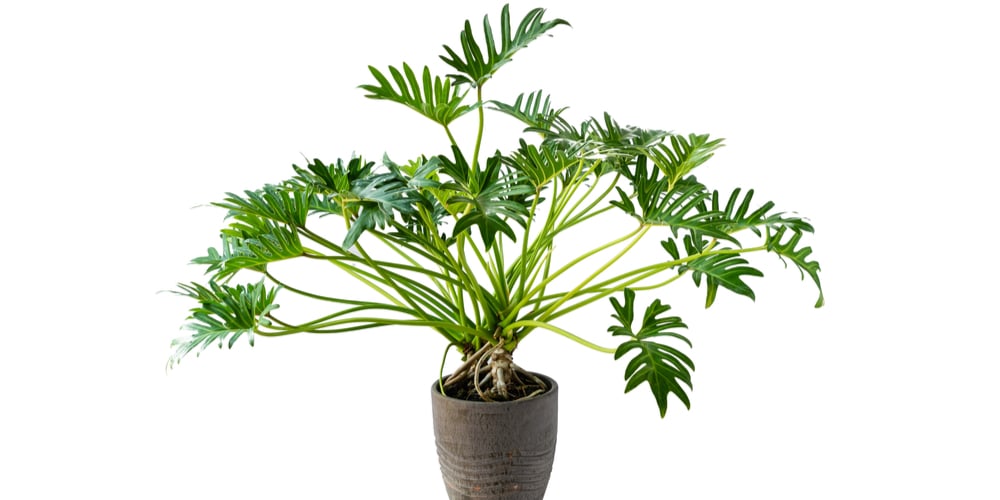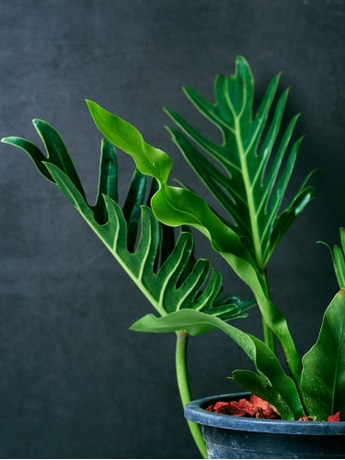The Philodendron Xanadu is a tropical evergreen plant that belongs to the Araceae family, and is easy to care for. Originating from the Brazilian rainforest, this plant is commonly kept as a house plant. It can also be grown outdoors in the right environment and does well in USDA zones 8 to 11.
The Philodendron Xanadu has dramatic green foliage that looks shiny. It gets quite tall and may require the support of a moss pole, although many specimens can support themselves. Let’s look at how to grow and care for a Philodendron Xanadu.
What is a Philodendron Xanadu?
The Philodendron Xanadu is a large rainforest shrub that climbs up other trees. It has dramatic green foliage, which looks stunning and makes them a popular houseplant. Many people think that the Philodendron Xanadu is a hybrid variety, in fact, it’s a plant that originates from the Brazilian rainforests.
The Philodendron Xanadu has glossy green foliage that feels leathery and grows into a dome shape, which at maturity has a beautifully patterned trunk. These plants can be grown as a houseplant or outdoors in landscapes in the right climate. They can tolerate a range of conditions but don’t like low humidity or direct sunlight. Outdoors these plants can grow in a sunny position or shaded areas beneath larger plants, trees, or shrubs.
Philodendron Xanadu is relatively fast-growing and can reach a height of 4 feet tall and 5 or 6 feet wide. When grown inside, they will stay smaller as their roots will be contained in a pot which will stunt growth. You can also prune your plant slightly so that it remains the desired shape and size.
Philodendron Xanadu plants have long, dark green leaves that grow to 14 inches and 12 inches wide. The look of the philodendron Xanadu improves as it matures and grows into a dense canopy.
Like all varieties of Philodendron, the Xanadu is toxic and shouldn’t be ingested by people or pets. These plants are incredibly toxic to cats and dogs. Ensure that you keep tropical plants such as the Philodendron Xanadu out of the reach of young children and pets.
How to Care for a Philodendron Xanadu
Philodendron Xanadu is generally considered to be a low-maintenance plant. They get relatively large and are great for outdoor landscapes as they provide a lovely backdrop for smaller plants. They are also tropical-looking plants which makes them a popular poolside choice.
Philodendron Xanadu also makes excellent houseplants and can be grown in the average home, as long as the lighting requirements are met. Here are some tips on how to care for a Philodendron Xanadu:
Soil
Philodendron Xanadu should be grown in soil that’s loose and well aerated. A well-draining soil is also beneficial, and you can add some organic matter such as peat moss or bark. These plants even grow in soil-less pre-mixtures or 100% sphagnum peat moss. You may like to try using peat-vermiculite or peat-perlite for growing a healthy Philodendron Xanadu.
Watering needs
Philodendron Xanadu is tropical and can be watered thoroughly using the ‘soak and dry method. You can generously water your plant in the growing season and then let the topsoil dry out before the next watering. It’s a wise idea to finger test the soil before watering. If the ground still feels moist, you can wait two or three days before watering.
If your philodendron’s leaves turn yellow or begin to wilt, this could be a sign that it’s either being over or under watered. You’ll need to test the soil to determine what the problem is. In most cases, the Philodendron Xanadu will recover quickly if you resume the correct watering schedule. You may need to report your plant and treat its roots with a fungicide if it’s been overwatered. To do this, remove waterlogged soil, cut off any roots that look black and feel soggy, apply a fungicide and then repot using new soil and a new pot. Don’t reuse the soil as it may contain fungus, which can spread to other plants.
Sunlight
The Philodendron Xanadu thrives in areas of bright, indirect sunlight. It’s best to place your plant near a sunny window so that it doesn’t get scorched by the sun’s rays. In some climates, the plant may be able to grow on the windowsill, but you should be aware that the plant’s foliage can get sunburnt through the glass.
If your plant is getting too much sunlight, its leaves will begin to turn yellow. When the odd leave begins to yellow, it may be because the leaf is old, multiple yellowing leaves indicate a problem with lighting.
If you notice that your plant’s stems have grown very tall and there are big spaces between the leaves, your plant may not be getting enough light.
Fertilizer
Philodendron Xanadu can be fertilized using a balanced houseplant fertilizer. It’s best to use a liquid fertilizer that’s formulated especially for tropical plants and contains macro-nutrients. You can feed your plant monthly throughout the growing season and every two months in the fall and winter.
If your plant’s growth seems to be slow and its leaves aren’t as big as expected, this is a sign that it requires fertilizer. Plants that produce pale foliage are likely to have either calcium or a magnesium deficiency. These are essential micro-nutrients for all varieties of philodendrons.
Temperature
Philodendron Xanadu thrives in temperatures that are between 65 and 78°F. They can cope with lower nighttime temperatures as long as it doesn’t get colder than 60°F.
Pests
Philodendrons are considered a fairly pest-resistant family of plants. However, you may see that your plant has some aphids or mealybugs. These insects are usually easy to get rid of; you can wipe them off with a damp cloth. Showering your plant with tepid water will help to wash off aphids, and if that fails, you can use insecticidal soap.
Conclusion
Philodendron Xanadu are beautiful tropical plants that are easy to care for. They thrive in loose, rich soil, which is well-draining. These plants need regular watering throughout the growing season. Philodendron Xanadu should be placed in filtered or indirect-sun or partial shade to avoid sunburn.

